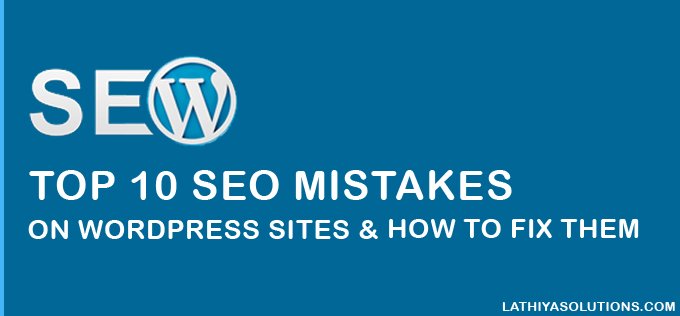WordPress is a popular platform for building websites and is now used by over 30% of the web, according to W3Techs.
If you want to create a website and increase traffic with SEO, WordPress is an excellent choice. Starting your website with SEO in mind can set you up for success, but it’s not always easy.
SEO aims to make your website more visible and to provide a smooth, user-friendly experience that leads to conversions.
Here are the top 10 SEO mistakes on WordPress sites that can hinder your site’s ranking and prevent visitors from taking action on your offers. Learn what these mistakes are and how to fix them.
1. Not Owning Your Own Domain
If you are serious about your website you will get your own name and host it yourself. Free blog setups do not do any favors for your SEO efforts.
That means your blog is not an address that looks like this: myblogname.wordpress.com.Using .blogspot and .wordpress is a great way to start and test out whether blogging is for you, to determine if you are willing to put in the time and effort to blog consistently. But if you want to take blogging really seriously you need to own your domain!
If still, you have confusion with web hosting then take help of Web Hosting service provider
2. Trying to rank for the wrong keywords
Make sure that you’re using the right keywords for every page. The longer and more specific the keywords are, the higher your chances of ranking for this keyword.
Try to focus on Long Tail Keyword, because it will increase your conversion rate highly.
3. Not Optimising Your Title Tag & Meta Description
A good page title is your bread-and-butter when it comes to SEO, it’s one of the first things search engines see when visiting your post. Also, try to close your keywords to the beginning of the title as possible.
Try to keep your title under 66 characters total, so that it doesn’t get cropped by search engines as this can cause fewer people to click on your post in Google.
A Meta description is the additional text that appears in SERPs, letting readers knows what the link is about. Your meta description should include the long-tail keyword you are trying to rank for because it will then become bold when people search for it and lead to more clicks to your blog post.
4. Neglecting to write awesome content
It’s important to make sure every page of your site has decent content and also at least 300 or 350 words in content. You can’t expect Google to see you as an expert on a certain topic when you have only written two sentences about it.
You must avoid duplicate content with other sites and be writing original content.
5. You Haven’t Submitted XML Sitemap
It’s hard to believe that bloggers can ignore something as critical as XML sitemaps, and yet there are people who make this mistake.
With an XML sitemap, you inform Google about the pages and posts you want to be indexed. A sitemap provides information on the frequency of updating and the relation of a URL with respect to other URLs. Sitemaps boost a site’s ranking in the SERPs. Sitemaps are easy to configure.
6. Not Using Internal Links To Your Other Blog Posts
Inbound links to your content help show search engines the validity or relevancy of your content. If you’ve written about a topic that’s mentioned in your blog post on another blog post, it’s a best practice to link to that page.
7. You Don’t Set Goals in Google Analytics
Suppose you gain more traffic in a month, but if those visitors don’t buy your products, or don’t perform actions that make you money, you’re going to be in trouble.
To measure how many people landed on those pages as well as how many of those visitors came from organic search you can use Google Analytics.
8. Disregarding Website Load Speed
A slow loading website is one of the many reasons why visitors leave a website. In today’s fast-paced generation, speed is everything.
The most famous speed-improving WP plugins include W3 Total Cache and Imagify Image Optimizer.W3 Total Cache improves your website speed primarily by minifying your site’s HTML, CSS, and JavaScript codes.
If you know how your website is doing in terms of site speed? You can use tools like Google PageSpeed Insights, Pingdom, and GTmetrix. Aside from showing you how fast your website loads, it also provides thorough recommendations on how to improve it.
9. Installing Yoast SEO and Just forgetting about it
The Yoast SEO plugin provides a content analysis tool for each of your posts, helping you create SEO-friendly blog posts every time. When you write a post that meets SEO best practices, Yoast indicates this with a green bullet. Having posts with green bullets can significantly improve your chances of ranking higher in search engine results.
10. You Don’t Check for Broken Links
Avoid pointing visitors towards any pages that are showing 400 or 500 errors and also make sure that all links to stay updated, To automate this process go to Check Your Broken Links.
If you can review this common mistake, make sure you avoid these common issues and well on the way to grow your organic traffic.
We know that SEO can often be confusing, if you have any questions please feel free to ask them in the comments.
